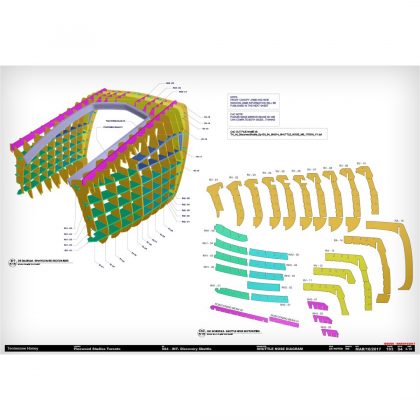Once more, the creative minds behind the artwork, graphics, and production design on Star Trek: Discovery are bringing their expertise to the public to talk about their work on the series, and share some never-seen behind-the-scenes images from the Toronto-based production.
Like a similar panel at Fan Expo Canada in 2017, the talented artists and designers behind Discovery‘s look will be presenting a special evening of production secrets from the show, where nine of the leading contributors to the series will be on hand to answer audience questions and discuss their crafts.
At the event, attendees can expect to learn loads of behind-the-scenes details about how Star Trek: Discovery is brought to life, as well as see never-before-released production documents and images from the sets — like these designs for the Discovery shuttlecraft build from set designer Michael Stanek.
The Ontario chapter of the Directors Guild of Canada will bring production designer Tamara Deverell, supervising art director Joshu de Cartier, set designers Matt Morgan, Emilie Poulin, Michael Stanek, and Chris Penna, and graphic designers Andy Tsang and Timothy Peel to a presentation Saturday evening hosted by Discovery art director Jody Clement at the TIFF Bell Lightbox in Toronto.
Registration for the event is free, and can be submitted at this link.
Ahead of the event, Discovery set designer Emilie Poulin spoke at length with the Motion Picture Association’s The Credits about the new Kelpien homeworld of Kaminar, first seen in December’s “The Brightest Star” Short Trek, and set to return later this season.
Filmed at Toronto’s Scarborough Bluff, Poulin described how the on-location set came to life.
“It’s just a bunch of bluffs and beaches. I had a friend come with a drone and aerial map the whole place and try to figure out square footage and how many kilometers between this and this and how can we build and at this time of the year how high is the water. That was really challenging.
Because we have never seen the Kelpien world before, we were free of canon. We got to be pretty vast in our gathering of inspiration. I made the decision not to look at any ‘alien world’ precedents, and tap into my days of playing in the dirt.
My reference image library was composed mostly of armadillo and turtle shells, deep sea creatures, bio-luminescent algae, and African mud huts.”
For the Kelpien living quarters, Poulin started with the angular look of Doug Jones’ facial prosthetic.
“The structure we designed was a pair of 18 sided elliptical huts, so, if you imagine 18 slices of 3-dimensional pie curving up to a circular peak. For the pattern of the facade, I took inspiration from Saru’s face.
I loosely traced the geometry of his cheekbones, philtrum, and brow and then developed a series of iterations with them – extruded, stretched, and mirrored the linework until I came to a form that felt original and exuded the essence of the Kelpien race.
We had to think about how the Kelpiens would have realistically built the huts themselves. For our purposes, we needed to design a very detailed steel structure, with removable walls for the camera, spaces within the walls for electric requirements.
But to uphold the story, it needed to appear as though the characters had constructed the huts themselves out of indigenous materials such as mud, algae, sticks, and plant matter.”
![]()
TrekCore will be on the scene for the Saturday evening presentation, so watch for live coverage of the event on our Twitter feed!






